Leaders vs Managers: Critical Discussion on Leadership Styles
VerifiedAdded on 2023/04/11
|9
|3780
|152
Essay
AI Summary
This essay provides a critical discussion on the differences between leaders and managers, highlighting that leaders transform while managers transact. It explores leadership qualities, types of leaders, and the roles of managers at different levels. The essay differentiates between management and leadership, emphasizing that management focuses on efficiency and task completion, while leadership is about vision, inspiration, and followers. It discusses trait theory and the importance of both leadership and management skills for organizational success. Ultimately, the essay argues that while managers focus on achieving goals and tasks, leaders inspire employees and ensure continuous improvement, and both roles are essential for effective organizational performance. Desklib offers a platform to access similar solved assignments and past papers for students.
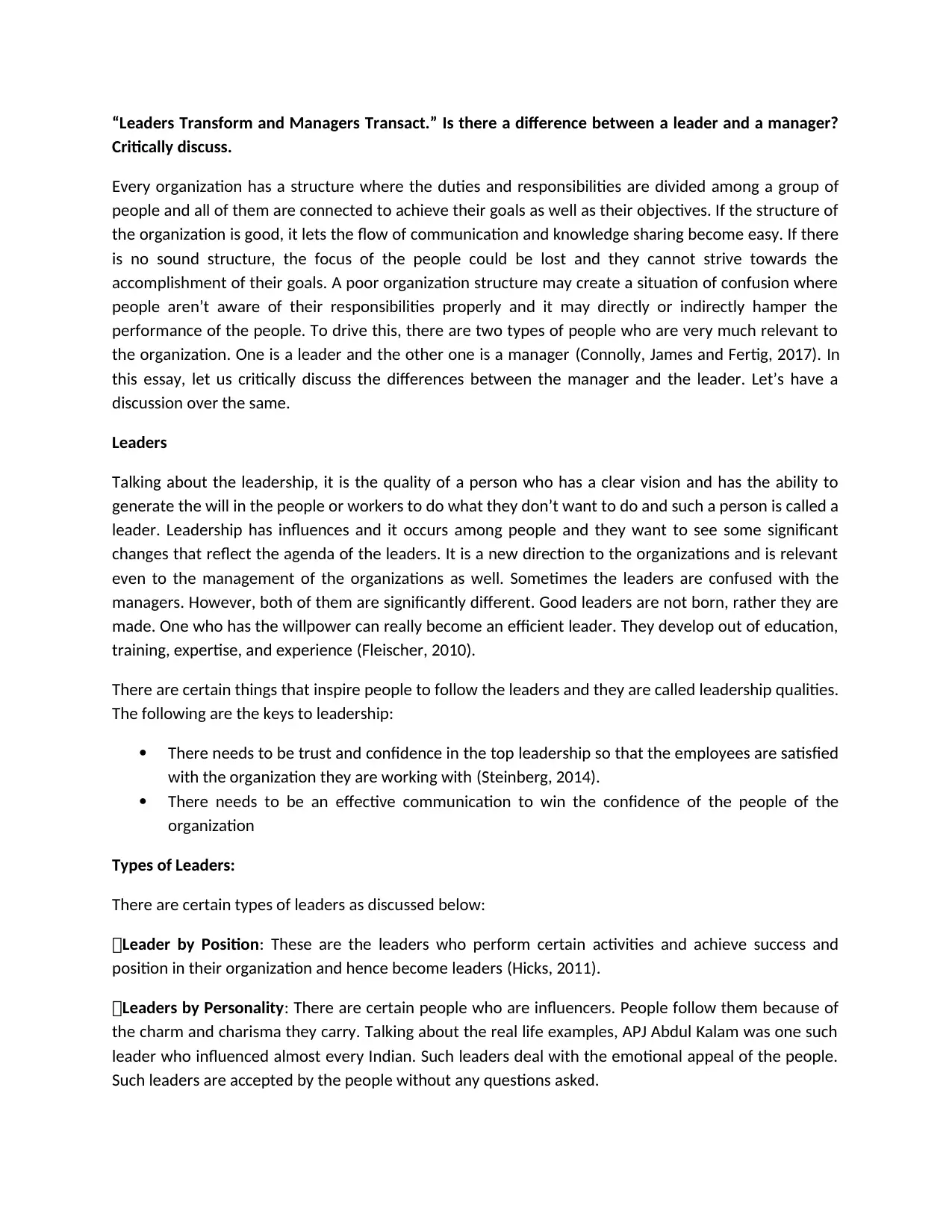
“Leaders Transform and Managers Transact.” Is there a difference between a leader and a manager?
Critically discuss.
Every organization has a structure where the duties and responsibilities are divided among a group of
people and all of them are connected to achieve their goals as well as their objectives. If the structure of
the organization is good, it lets the flow of communication and knowledge sharing become easy. If there
is no sound structure, the focus of the people could be lost and they cannot strive towards the
accomplishment of their goals. A poor organization structure may create a situation of confusion where
people aren’t aware of their responsibilities properly and it may directly or indirectly hamper the
performance of the people. To drive this, there are two types of people who are very much relevant to
the organization. One is a leader and the other one is a manager (Connolly, James and Fertig, 2017). In
this essay, let us critically discuss the differences between the manager and the leader. Let’s have a
discussion over the same.
Leaders
Talking about the leadership, it is the quality of a person who has a clear vision and has the ability to
generate the will in the people or workers to do what they don’t want to do and such a person is called a
leader. Leadership has influences and it occurs among people and they want to see some significant
changes that reflect the agenda of the leaders. It is a new direction to the organizations and is relevant
even to the management of the organizations as well. Sometimes the leaders are confused with the
managers. However, both of them are significantly different. Good leaders are not born, rather they are
made. One who has the willpower can really become an efficient leader. They develop out of education,
training, expertise, and experience (Fleischer, 2010).
There are certain things that inspire people to follow the leaders and they are called leadership qualities.
The following are the keys to leadership:
There needs to be trust and confidence in the top leadership so that the employees are satisfied
with the organization they are working with (Steinberg, 2014).
There needs to be an effective communication to win the confidence of the people of the
organization
Types of Leaders:
There are certain types of leaders as discussed below:
Leader by Position: These are the leaders who perform certain activities and achieve success and
position in their organization and hence become leaders (Hicks, 2011).
Leaders by Personality: There are certain people who are influencers. People follow them because of
the charm and charisma they carry. Talking about the real life examples, APJ Abdul Kalam was one such
leader who influenced almost every Indian. Such leaders deal with the emotional appeal of the people.
Such leaders are accepted by the people without any questions asked.
Critically discuss.
Every organization has a structure where the duties and responsibilities are divided among a group of
people and all of them are connected to achieve their goals as well as their objectives. If the structure of
the organization is good, it lets the flow of communication and knowledge sharing become easy. If there
is no sound structure, the focus of the people could be lost and they cannot strive towards the
accomplishment of their goals. A poor organization structure may create a situation of confusion where
people aren’t aware of their responsibilities properly and it may directly or indirectly hamper the
performance of the people. To drive this, there are two types of people who are very much relevant to
the organization. One is a leader and the other one is a manager (Connolly, James and Fertig, 2017). In
this essay, let us critically discuss the differences between the manager and the leader. Let’s have a
discussion over the same.
Leaders
Talking about the leadership, it is the quality of a person who has a clear vision and has the ability to
generate the will in the people or workers to do what they don’t want to do and such a person is called a
leader. Leadership has influences and it occurs among people and they want to see some significant
changes that reflect the agenda of the leaders. It is a new direction to the organizations and is relevant
even to the management of the organizations as well. Sometimes the leaders are confused with the
managers. However, both of them are significantly different. Good leaders are not born, rather they are
made. One who has the willpower can really become an efficient leader. They develop out of education,
training, expertise, and experience (Fleischer, 2010).
There are certain things that inspire people to follow the leaders and they are called leadership qualities.
The following are the keys to leadership:
There needs to be trust and confidence in the top leadership so that the employees are satisfied
with the organization they are working with (Steinberg, 2014).
There needs to be an effective communication to win the confidence of the people of the
organization
Types of Leaders:
There are certain types of leaders as discussed below:
Leader by Position: These are the leaders who perform certain activities and achieve success and
position in their organization and hence become leaders (Hicks, 2011).
Leaders by Personality: There are certain people who are influencers. People follow them because of
the charm and charisma they carry. Talking about the real life examples, APJ Abdul Kalam was one such
leader who influenced almost every Indian. Such leaders deal with the emotional appeal of the people.
Such leaders are accepted by the people without any questions asked.
Paraphrase This Document
Need a fresh take? Get an instant paraphrase of this document with our AI Paraphraser
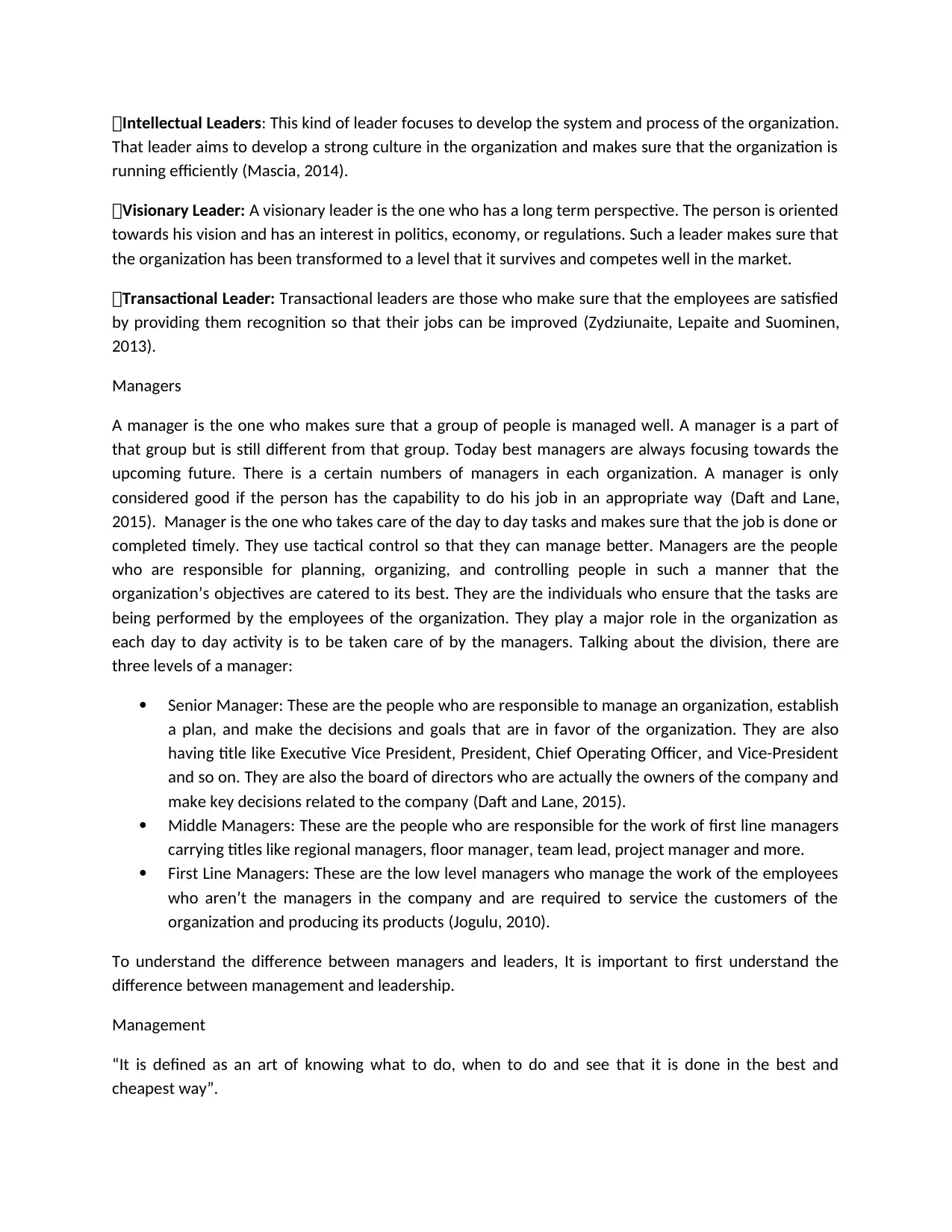
Intellectual Leaders: This kind of leader focuses to develop the system and process of the organization.
That leader aims to develop a strong culture in the organization and makes sure that the organization is
running efficiently (Mascia, 2014).
Visionary Leader: A visionary leader is the one who has a long term perspective. The person is oriented
towards his vision and has an interest in politics, economy, or regulations. Such a leader makes sure that
the organization has been transformed to a level that it survives and competes well in the market.
Transactional Leader: Transactional leaders are those who make sure that the employees are satisfied
by providing them recognition so that their jobs can be improved (Zydziunaite, Lepaite and Suominen,
2013).
Managers
A manager is the one who makes sure that a group of people is managed well. A manager is a part of
that group but is still different from that group. Today best managers are always focusing towards the
upcoming future. There is a certain numbers of managers in each organization. A manager is only
considered good if the person has the capability to do his job in an appropriate way (Daft and Lane,
2015). Manager is the one who takes care of the day to day tasks and makes sure that the job is done or
completed timely. They use tactical control so that they can manage better. Managers are the people
who are responsible for planning, organizing, and controlling people in such a manner that the
organization’s objectives are catered to its best. They are the individuals who ensure that the tasks are
being performed by the employees of the organization. They play a major role in the organization as
each day to day activity is to be taken care of by the managers. Talking about the division, there are
three levels of a manager:
Senior Manager: These are the people who are responsible to manage an organization, establish
a plan, and make the decisions and goals that are in favor of the organization. They are also
having title like Executive Vice President, President, Chief Operating Officer, and Vice-President
and so on. They are also the board of directors who are actually the owners of the company and
make key decisions related to the company (Daft and Lane, 2015).
Middle Managers: These are the people who are responsible for the work of first line managers
carrying titles like regional managers, floor manager, team lead, project manager and more.
First Line Managers: These are the low level managers who manage the work of the employees
who aren’t the managers in the company and are required to service the customers of the
organization and producing its products (Jogulu, 2010).
To understand the difference between managers and leaders, It is important to first understand the
difference between management and leadership.
Management
“It is defined as an art of knowing what to do, when to do and see that it is done in the best and
cheapest way”.
That leader aims to develop a strong culture in the organization and makes sure that the organization is
running efficiently (Mascia, 2014).
Visionary Leader: A visionary leader is the one who has a long term perspective. The person is oriented
towards his vision and has an interest in politics, economy, or regulations. Such a leader makes sure that
the organization has been transformed to a level that it survives and competes well in the market.
Transactional Leader: Transactional leaders are those who make sure that the employees are satisfied
by providing them recognition so that their jobs can be improved (Zydziunaite, Lepaite and Suominen,
2013).
Managers
A manager is the one who makes sure that a group of people is managed well. A manager is a part of
that group but is still different from that group. Today best managers are always focusing towards the
upcoming future. There is a certain numbers of managers in each organization. A manager is only
considered good if the person has the capability to do his job in an appropriate way (Daft and Lane,
2015). Manager is the one who takes care of the day to day tasks and makes sure that the job is done or
completed timely. They use tactical control so that they can manage better. Managers are the people
who are responsible for planning, organizing, and controlling people in such a manner that the
organization’s objectives are catered to its best. They are the individuals who ensure that the tasks are
being performed by the employees of the organization. They play a major role in the organization as
each day to day activity is to be taken care of by the managers. Talking about the division, there are
three levels of a manager:
Senior Manager: These are the people who are responsible to manage an organization, establish
a plan, and make the decisions and goals that are in favor of the organization. They are also
having title like Executive Vice President, President, Chief Operating Officer, and Vice-President
and so on. They are also the board of directors who are actually the owners of the company and
make key decisions related to the company (Daft and Lane, 2015).
Middle Managers: These are the people who are responsible for the work of first line managers
carrying titles like regional managers, floor manager, team lead, project manager and more.
First Line Managers: These are the low level managers who manage the work of the employees
who aren’t the managers in the company and are required to service the customers of the
organization and producing its products (Jogulu, 2010).
To understand the difference between managers and leaders, It is important to first understand the
difference between management and leadership.
Management
“It is defined as an art of knowing what to do, when to do and see that it is done in the best and
cheapest way”.
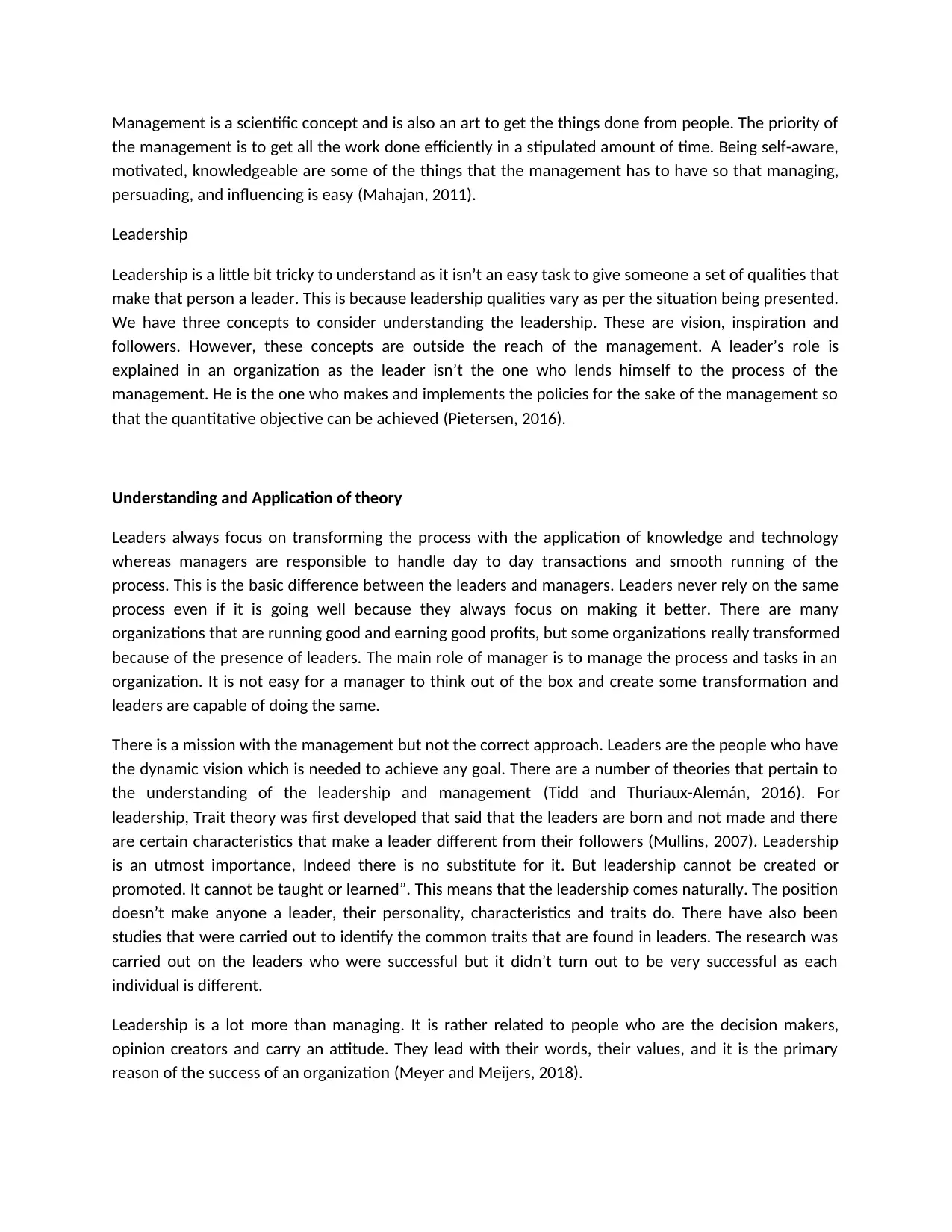
Management is a scientific concept and is also an art to get the things done from people. The priority of
the management is to get all the work done efficiently in a stipulated amount of time. Being self-aware,
motivated, knowledgeable are some of the things that the management has to have so that managing,
persuading, and influencing is easy (Mahajan, 2011).
Leadership
Leadership is a little bit tricky to understand as it isn’t an easy task to give someone a set of qualities that
make that person a leader. This is because leadership qualities vary as per the situation being presented.
We have three concepts to consider understanding the leadership. These are vision, inspiration and
followers. However, these concepts are outside the reach of the management. A leader’s role is
explained in an organization as the leader isn’t the one who lends himself to the process of the
management. He is the one who makes and implements the policies for the sake of the management so
that the quantitative objective can be achieved (Pietersen, 2016).
Understanding and Application of theory
Leaders always focus on transforming the process with the application of knowledge and technology
whereas managers are responsible to handle day to day transactions and smooth running of the
process. This is the basic difference between the leaders and managers. Leaders never rely on the same
process even if it is going well because they always focus on making it better. There are many
organizations that are running good and earning good profits, but some organizations really transformed
because of the presence of leaders. The main role of manager is to manage the process and tasks in an
organization. It is not easy for a manager to think out of the box and create some transformation and
leaders are capable of doing the same.
There is a mission with the management but not the correct approach. Leaders are the people who have
the dynamic vision which is needed to achieve any goal. There are a number of theories that pertain to
the understanding of the leadership and management (Tidd and Thuriaux-Alemán, 2016). For
leadership, Trait theory was first developed that said that the leaders are born and not made and there
are certain characteristics that make a leader different from their followers (Mullins, 2007). Leadership
is an utmost importance, Indeed there is no substitute for it. But leadership cannot be created or
promoted. It cannot be taught or learned”. This means that the leadership comes naturally. The position
doesn’t make anyone a leader, their personality, characteristics and traits do. There have also been
studies that were carried out to identify the common traits that are found in leaders. The research was
carried out on the leaders who were successful but it didn’t turn out to be very successful as each
individual is different.
Leadership is a lot more than managing. It is rather related to people who are the decision makers,
opinion creators and carry an attitude. They lead with their words, their values, and it is the primary
reason of the success of an organization (Meyer and Meijers, 2018).
the management is to get all the work done efficiently in a stipulated amount of time. Being self-aware,
motivated, knowledgeable are some of the things that the management has to have so that managing,
persuading, and influencing is easy (Mahajan, 2011).
Leadership
Leadership is a little bit tricky to understand as it isn’t an easy task to give someone a set of qualities that
make that person a leader. This is because leadership qualities vary as per the situation being presented.
We have three concepts to consider understanding the leadership. These are vision, inspiration and
followers. However, these concepts are outside the reach of the management. A leader’s role is
explained in an organization as the leader isn’t the one who lends himself to the process of the
management. He is the one who makes and implements the policies for the sake of the management so
that the quantitative objective can be achieved (Pietersen, 2016).
Understanding and Application of theory
Leaders always focus on transforming the process with the application of knowledge and technology
whereas managers are responsible to handle day to day transactions and smooth running of the
process. This is the basic difference between the leaders and managers. Leaders never rely on the same
process even if it is going well because they always focus on making it better. There are many
organizations that are running good and earning good profits, but some organizations really transformed
because of the presence of leaders. The main role of manager is to manage the process and tasks in an
organization. It is not easy for a manager to think out of the box and create some transformation and
leaders are capable of doing the same.
There is a mission with the management but not the correct approach. Leaders are the people who have
the dynamic vision which is needed to achieve any goal. There are a number of theories that pertain to
the understanding of the leadership and management (Tidd and Thuriaux-Alemán, 2016). For
leadership, Trait theory was first developed that said that the leaders are born and not made and there
are certain characteristics that make a leader different from their followers (Mullins, 2007). Leadership
is an utmost importance, Indeed there is no substitute for it. But leadership cannot be created or
promoted. It cannot be taught or learned”. This means that the leadership comes naturally. The position
doesn’t make anyone a leader, their personality, characteristics and traits do. There have also been
studies that were carried out to identify the common traits that are found in leaders. The research was
carried out on the leaders who were successful but it didn’t turn out to be very successful as each
individual is different.
Leadership is a lot more than managing. It is rather related to people who are the decision makers,
opinion creators and carry an attitude. They lead with their words, their values, and it is the primary
reason of the success of an organization (Meyer and Meijers, 2018).
⊘ This is a preview!⊘
Do you want full access?
Subscribe today to unlock all pages.

Trusted by 1+ million students worldwide
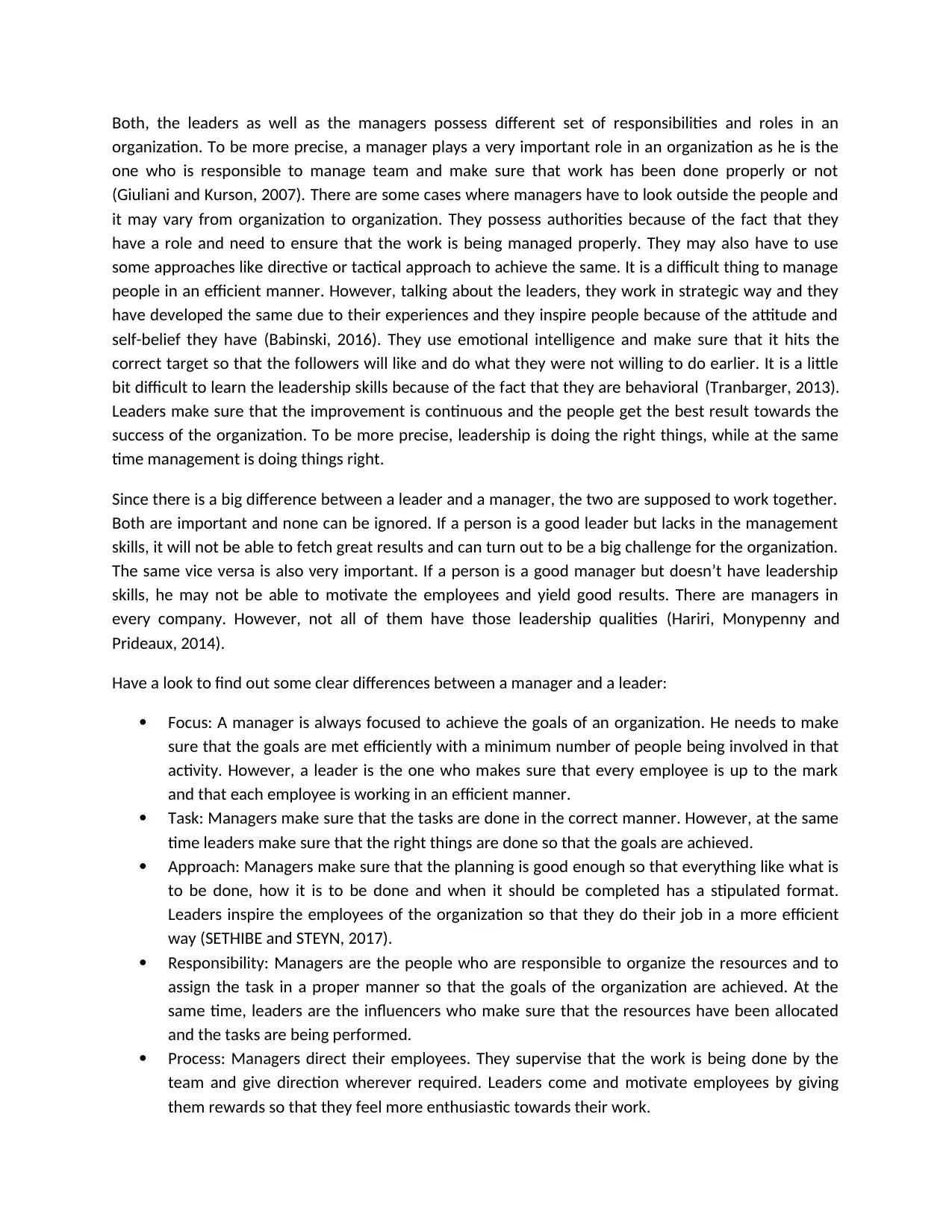
Both, the leaders as well as the managers possess different set of responsibilities and roles in an
organization. To be more precise, a manager plays a very important role in an organization as he is the
one who is responsible to manage team and make sure that work has been done properly or not
(Giuliani and Kurson, 2007). There are some cases where managers have to look outside the people and
it may vary from organization to organization. They possess authorities because of the fact that they
have a role and need to ensure that the work is being managed properly. They may also have to use
some approaches like directive or tactical approach to achieve the same. It is a difficult thing to manage
people in an efficient manner. However, talking about the leaders, they work in strategic way and they
have developed the same due to their experiences and they inspire people because of the attitude and
self-belief they have (Babinski, 2016). They use emotional intelligence and make sure that it hits the
correct target so that the followers will like and do what they were not willing to do earlier. It is a little
bit difficult to learn the leadership skills because of the fact that they are behavioral (Tranbarger, 2013).
Leaders make sure that the improvement is continuous and the people get the best result towards the
success of the organization. To be more precise, leadership is doing the right things, while at the same
time management is doing things right.
Since there is a big difference between a leader and a manager, the two are supposed to work together.
Both are important and none can be ignored. If a person is a good leader but lacks in the management
skills, it will not be able to fetch great results and can turn out to be a big challenge for the organization.
The same vice versa is also very important. If a person is a good manager but doesn’t have leadership
skills, he may not be able to motivate the employees and yield good results. There are managers in
every company. However, not all of them have those leadership qualities (Hariri, Monypenny and
Prideaux, 2014).
Have a look to find out some clear differences between a manager and a leader:
Focus: A manager is always focused to achieve the goals of an organization. He needs to make
sure that the goals are met efficiently with a minimum number of people being involved in that
activity. However, a leader is the one who makes sure that every employee is up to the mark
and that each employee is working in an efficient manner.
Task: Managers make sure that the tasks are done in the correct manner. However, at the same
time leaders make sure that the right things are done so that the goals are achieved.
Approach: Managers make sure that the planning is good enough so that everything like what is
to be done, how it is to be done and when it should be completed has a stipulated format.
Leaders inspire the employees of the organization so that they do their job in a more efficient
way (SETHIBE and STEYN, 2017).
Responsibility: Managers are the people who are responsible to organize the resources and to
assign the task in a proper manner so that the goals of the organization are achieved. At the
same time, leaders are the influencers who make sure that the resources have been allocated
and the tasks are being performed.
Process: Managers direct their employees. They supervise that the work is being done by the
team and give direction wherever required. Leaders come and motivate employees by giving
them rewards so that they feel more enthusiastic towards their work.
organization. To be more precise, a manager plays a very important role in an organization as he is the
one who is responsible to manage team and make sure that work has been done properly or not
(Giuliani and Kurson, 2007). There are some cases where managers have to look outside the people and
it may vary from organization to organization. They possess authorities because of the fact that they
have a role and need to ensure that the work is being managed properly. They may also have to use
some approaches like directive or tactical approach to achieve the same. It is a difficult thing to manage
people in an efficient manner. However, talking about the leaders, they work in strategic way and they
have developed the same due to their experiences and they inspire people because of the attitude and
self-belief they have (Babinski, 2016). They use emotional intelligence and make sure that it hits the
correct target so that the followers will like and do what they were not willing to do earlier. It is a little
bit difficult to learn the leadership skills because of the fact that they are behavioral (Tranbarger, 2013).
Leaders make sure that the improvement is continuous and the people get the best result towards the
success of the organization. To be more precise, leadership is doing the right things, while at the same
time management is doing things right.
Since there is a big difference between a leader and a manager, the two are supposed to work together.
Both are important and none can be ignored. If a person is a good leader but lacks in the management
skills, it will not be able to fetch great results and can turn out to be a big challenge for the organization.
The same vice versa is also very important. If a person is a good manager but doesn’t have leadership
skills, he may not be able to motivate the employees and yield good results. There are managers in
every company. However, not all of them have those leadership qualities (Hariri, Monypenny and
Prideaux, 2014).
Have a look to find out some clear differences between a manager and a leader:
Focus: A manager is always focused to achieve the goals of an organization. He needs to make
sure that the goals are met efficiently with a minimum number of people being involved in that
activity. However, a leader is the one who makes sure that every employee is up to the mark
and that each employee is working in an efficient manner.
Task: Managers make sure that the tasks are done in the correct manner. However, at the same
time leaders make sure that the right things are done so that the goals are achieved.
Approach: Managers make sure that the planning is good enough so that everything like what is
to be done, how it is to be done and when it should be completed has a stipulated format.
Leaders inspire the employees of the organization so that they do their job in a more efficient
way (SETHIBE and STEYN, 2017).
Responsibility: Managers are the people who are responsible to organize the resources and to
assign the task in a proper manner so that the goals of the organization are achieved. At the
same time, leaders are the influencers who make sure that the resources have been allocated
and the tasks are being performed.
Process: Managers direct their employees. They supervise that the work is being done by the
team and give direction wherever required. Leaders come and motivate employees by giving
them rewards so that they feel more enthusiastic towards their work.
Paraphrase This Document
Need a fresh take? Get an instant paraphrase of this document with our AI Paraphraser
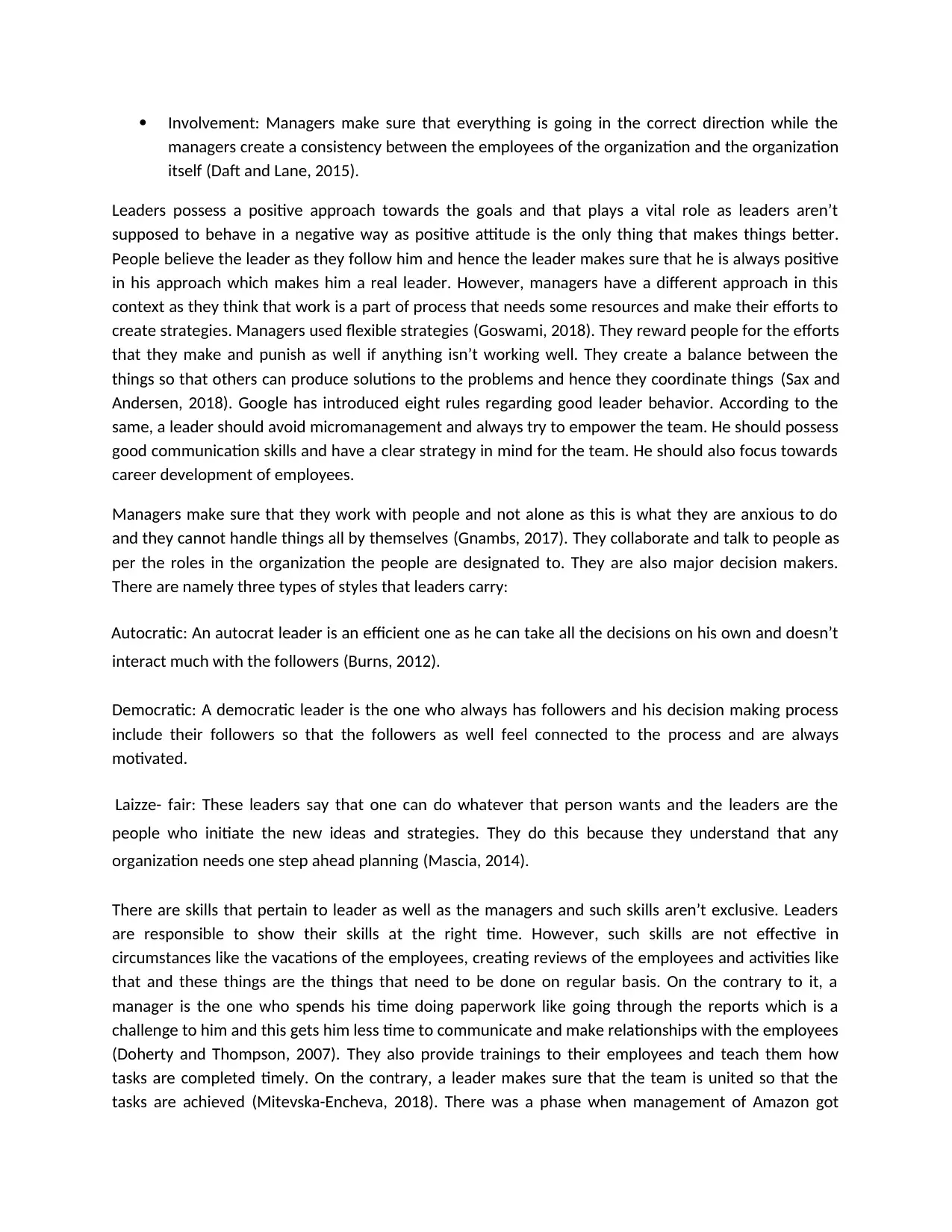
Involvement: Managers make sure that everything is going in the correct direction while the
managers create a consistency between the employees of the organization and the organization
itself (Daft and Lane, 2015).
Leaders possess a positive approach towards the goals and that plays a vital role as leaders aren’t
supposed to behave in a negative way as positive attitude is the only thing that makes things better.
People believe the leader as they follow him and hence the leader makes sure that he is always positive
in his approach which makes him a real leader. However, managers have a different approach in this
context as they think that work is a part of process that needs some resources and make their efforts to
create strategies. Managers used flexible strategies (Goswami, 2018). They reward people for the efforts
that they make and punish as well if anything isn’t working well. They create a balance between the
things so that others can produce solutions to the problems and hence they coordinate things (Sax and
Andersen, 2018). Google has introduced eight rules regarding good leader behavior. According to the
same, a leader should avoid micromanagement and always try to empower the team. He should possess
good communication skills and have a clear strategy in mind for the team. He should also focus towards
career development of employees.
Managers make sure that they work with people and not alone as this is what they are anxious to do
and they cannot handle things all by themselves (Gnambs, 2017). They collaborate and talk to people as
per the roles in the organization the people are designated to. They are also major decision makers.
There are namely three types of styles that leaders carry:
Autocratic: An autocrat leader is an efficient one as he can take all the decisions on his own and doesn’t
interact much with the followers (Burns, 2012).
Democratic: A democratic leader is the one who always has followers and his decision making process
include their followers so that the followers as well feel connected to the process and are always
motivated.
Laizze- fair: These leaders say that one can do whatever that person wants and the leaders are the
people who initiate the new ideas and strategies. They do this because they understand that any
organization needs one step ahead planning (Mascia, 2014).
There are skills that pertain to leader as well as the managers and such skills aren’t exclusive. Leaders
are responsible to show their skills at the right time. However, such skills are not effective in
circumstances like the vacations of the employees, creating reviews of the employees and activities like
that and these things are the things that need to be done on regular basis. On the contrary to it, a
manager is the one who spends his time doing paperwork like going through the reports which is a
challenge to him and this gets him less time to communicate and make relationships with the employees
(Doherty and Thompson, 2007). They also provide trainings to their employees and teach them how
tasks are completed timely. On the contrary, a leader makes sure that the team is united so that the
tasks are achieved (Mitevska-Encheva, 2018). There was a phase when management of Amazon got
managers create a consistency between the employees of the organization and the organization
itself (Daft and Lane, 2015).
Leaders possess a positive approach towards the goals and that plays a vital role as leaders aren’t
supposed to behave in a negative way as positive attitude is the only thing that makes things better.
People believe the leader as they follow him and hence the leader makes sure that he is always positive
in his approach which makes him a real leader. However, managers have a different approach in this
context as they think that work is a part of process that needs some resources and make their efforts to
create strategies. Managers used flexible strategies (Goswami, 2018). They reward people for the efforts
that they make and punish as well if anything isn’t working well. They create a balance between the
things so that others can produce solutions to the problems and hence they coordinate things (Sax and
Andersen, 2018). Google has introduced eight rules regarding good leader behavior. According to the
same, a leader should avoid micromanagement and always try to empower the team. He should possess
good communication skills and have a clear strategy in mind for the team. He should also focus towards
career development of employees.
Managers make sure that they work with people and not alone as this is what they are anxious to do
and they cannot handle things all by themselves (Gnambs, 2017). They collaborate and talk to people as
per the roles in the organization the people are designated to. They are also major decision makers.
There are namely three types of styles that leaders carry:
Autocratic: An autocrat leader is an efficient one as he can take all the decisions on his own and doesn’t
interact much with the followers (Burns, 2012).
Democratic: A democratic leader is the one who always has followers and his decision making process
include their followers so that the followers as well feel connected to the process and are always
motivated.
Laizze- fair: These leaders say that one can do whatever that person wants and the leaders are the
people who initiate the new ideas and strategies. They do this because they understand that any
organization needs one step ahead planning (Mascia, 2014).
There are skills that pertain to leader as well as the managers and such skills aren’t exclusive. Leaders
are responsible to show their skills at the right time. However, such skills are not effective in
circumstances like the vacations of the employees, creating reviews of the employees and activities like
that and these things are the things that need to be done on regular basis. On the contrary to it, a
manager is the one who spends his time doing paperwork like going through the reports which is a
challenge to him and this gets him less time to communicate and make relationships with the employees
(Doherty and Thompson, 2007). They also provide trainings to their employees and teach them how
tasks are completed timely. On the contrary, a leader makes sure that the team is united so that the
tasks are achieved (Mitevska-Encheva, 2018). There was a phase when management of Amazon got

failed and the reason behind the same was not listening to customer’s problems, failure to describe
performance objectives and unable to motivate its employees. Afterwards, they started working upon
these issues.
Managers think that taking risks is obvious so that the short term goals are fulfilled and there can be
long term goals as well that can be fulfilled. They have the responsibility to focus on the results on a
daily basis and run the tasks daily so that the goals and objectives that are to be achieved can be
accomplished (Babinski, 2016). However, leaders are concerned about their future and not about the
past. They consistently make sure that something new cam come up like new technology, equipment or
maybe labor. This may turn out to get them better opportunities in the market. Leaders majorly
concentrate to motivate people and trying to involve them in the decision making process of the
organization so that they feel connected to the organization. Leaders don’t just communicate well; they
also possess the ability to listen to everyone. In an organization, every person is assigned to a specific
job. However, as per the leaders there needs to job a rotation of the job so that everyone is on the same
page and people can develop skills and can take up new challenges (Daft and Lane, 2015). This doesn’t
imply that managers don’t motivate people, they also do but in terms of the benefits like overtime
allowance, salary increment and the benefits that the company offers. Managers think more about the
results as well as the performance of the company (Parker and Welch, 2013). Doing this, they compare
the same with the historical records that helps them analyze the situation and the output produces as
well as the profits. They try to provide some benefits related to the company so that they get motivated
to work. It surely is the case that managers are not considered real good motivators, but motivating in
terms of financial benefits like salary is what leaders cannot do and hence managers are also very
important to the success of the organization just like leaders. There can only be success in an
organization where leaders and managers work together, there only one can expect success (Babiak,
2014).
This concludes the fact that “Leaders transform and Manager transact”. Leaders are the primary reason
that the transformation happens because of the fact that the qualities as well as the attitude and
attributes of the leaders is sole thing that motivates followers and they work like they have taken the
ownership of their tasks. They bring such a change in the employees that they tend to work with the
best of their efforts. Leaders treat their followers in such a manner that they don’t have to follow any
set of rules and regulations. They don’t follow any norms that they follow to motivate the employees.
Managers transact and make sure that by motivating with the financial benefits, they are able to achieve
the short-term goals of the company (Connolly, James and Fertig, 2017).
However, at the same time leaders also have to transact as they get involved in supervision,
organization, and the performance which is an integral part of the leadership model. It works at the
basic level of the satisfaction of the needs. They are also involved in day to day activities of the
organization and need to keep a watch on the tasks on a daily basis as they also make sure that the goals
of the organization are achieved. Managers maintain a formal relationship as they need to handle each
employee in the most efficient manner. There are a number of differences between a leader and a
manager but at the same time they complement each other. It becomes imperative for an organization
performance objectives and unable to motivate its employees. Afterwards, they started working upon
these issues.
Managers think that taking risks is obvious so that the short term goals are fulfilled and there can be
long term goals as well that can be fulfilled. They have the responsibility to focus on the results on a
daily basis and run the tasks daily so that the goals and objectives that are to be achieved can be
accomplished (Babinski, 2016). However, leaders are concerned about their future and not about the
past. They consistently make sure that something new cam come up like new technology, equipment or
maybe labor. This may turn out to get them better opportunities in the market. Leaders majorly
concentrate to motivate people and trying to involve them in the decision making process of the
organization so that they feel connected to the organization. Leaders don’t just communicate well; they
also possess the ability to listen to everyone. In an organization, every person is assigned to a specific
job. However, as per the leaders there needs to job a rotation of the job so that everyone is on the same
page and people can develop skills and can take up new challenges (Daft and Lane, 2015). This doesn’t
imply that managers don’t motivate people, they also do but in terms of the benefits like overtime
allowance, salary increment and the benefits that the company offers. Managers think more about the
results as well as the performance of the company (Parker and Welch, 2013). Doing this, they compare
the same with the historical records that helps them analyze the situation and the output produces as
well as the profits. They try to provide some benefits related to the company so that they get motivated
to work. It surely is the case that managers are not considered real good motivators, but motivating in
terms of financial benefits like salary is what leaders cannot do and hence managers are also very
important to the success of the organization just like leaders. There can only be success in an
organization where leaders and managers work together, there only one can expect success (Babiak,
2014).
This concludes the fact that “Leaders transform and Manager transact”. Leaders are the primary reason
that the transformation happens because of the fact that the qualities as well as the attitude and
attributes of the leaders is sole thing that motivates followers and they work like they have taken the
ownership of their tasks. They bring such a change in the employees that they tend to work with the
best of their efforts. Leaders treat their followers in such a manner that they don’t have to follow any
set of rules and regulations. They don’t follow any norms that they follow to motivate the employees.
Managers transact and make sure that by motivating with the financial benefits, they are able to achieve
the short-term goals of the company (Connolly, James and Fertig, 2017).
However, at the same time leaders also have to transact as they get involved in supervision,
organization, and the performance which is an integral part of the leadership model. It works at the
basic level of the satisfaction of the needs. They are also involved in day to day activities of the
organization and need to keep a watch on the tasks on a daily basis as they also make sure that the goals
of the organization are achieved. Managers maintain a formal relationship as they need to handle each
employee in the most efficient manner. There are a number of differences between a leader and a
manager but at the same time they complement each other. It becomes imperative for an organization
⊘ This is a preview!⊘
Do you want full access?
Subscribe today to unlock all pages.

Trusted by 1+ million students worldwide
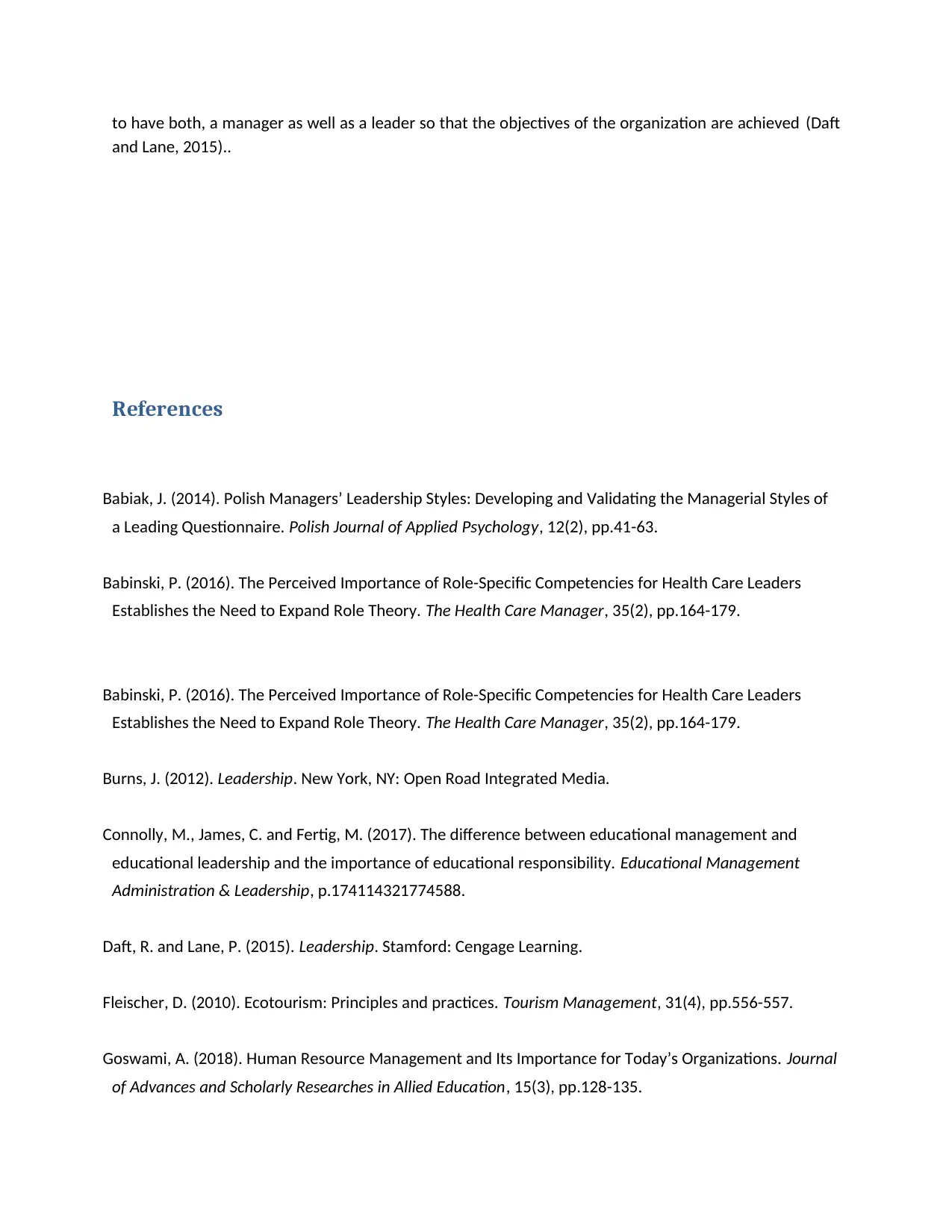
to have both, a manager as well as a leader so that the objectives of the organization are achieved (Daft
and Lane, 2015)..
References
Babiak, J. (2014). Polish Managers’ Leadership Styles: Developing and Validating the Managerial Styles of
a Leading Questionnaire. Polish Journal of Applied Psychology, 12(2), pp.41-63.
Babinski, P. (2016). The Perceived Importance of Role-Specific Competencies for Health Care Leaders
Establishes the Need to Expand Role Theory. The Health Care Manager, 35(2), pp.164-179.
Babinski, P. (2016). The Perceived Importance of Role-Specific Competencies for Health Care Leaders
Establishes the Need to Expand Role Theory. The Health Care Manager, 35(2), pp.164-179.
Burns, J. (2012). Leadership. New York, NY: Open Road Integrated Media.
Connolly, M., James, C. and Fertig, M. (2017). The difference between educational management and
educational leadership and the importance of educational responsibility. Educational Management
Administration & Leadership, p.174114321774588.
Daft, R. and Lane, P. (2015). Leadership. Stamford: Cengage Learning.
Fleischer, D. (2010). Ecotourism: Principles and practices. Tourism Management, 31(4), pp.556-557.
Goswami, A. (2018). Human Resource Management and Its Importance for Today’s Organizations. Journal
of Advances and Scholarly Researches in Allied Education, 15(3), pp.128-135.
and Lane, 2015)..
References
Babiak, J. (2014). Polish Managers’ Leadership Styles: Developing and Validating the Managerial Styles of
a Leading Questionnaire. Polish Journal of Applied Psychology, 12(2), pp.41-63.
Babinski, P. (2016). The Perceived Importance of Role-Specific Competencies for Health Care Leaders
Establishes the Need to Expand Role Theory. The Health Care Manager, 35(2), pp.164-179.
Babinski, P. (2016). The Perceived Importance of Role-Specific Competencies for Health Care Leaders
Establishes the Need to Expand Role Theory. The Health Care Manager, 35(2), pp.164-179.
Burns, J. (2012). Leadership. New York, NY: Open Road Integrated Media.
Connolly, M., James, C. and Fertig, M. (2017). The difference between educational management and
educational leadership and the importance of educational responsibility. Educational Management
Administration & Leadership, p.174114321774588.
Daft, R. and Lane, P. (2015). Leadership. Stamford: Cengage Learning.
Fleischer, D. (2010). Ecotourism: Principles and practices. Tourism Management, 31(4), pp.556-557.
Goswami, A. (2018). Human Resource Management and Its Importance for Today’s Organizations. Journal
of Advances and Scholarly Researches in Allied Education, 15(3), pp.128-135.
Paraphrase This Document
Need a fresh take? Get an instant paraphrase of this document with our AI Paraphraser
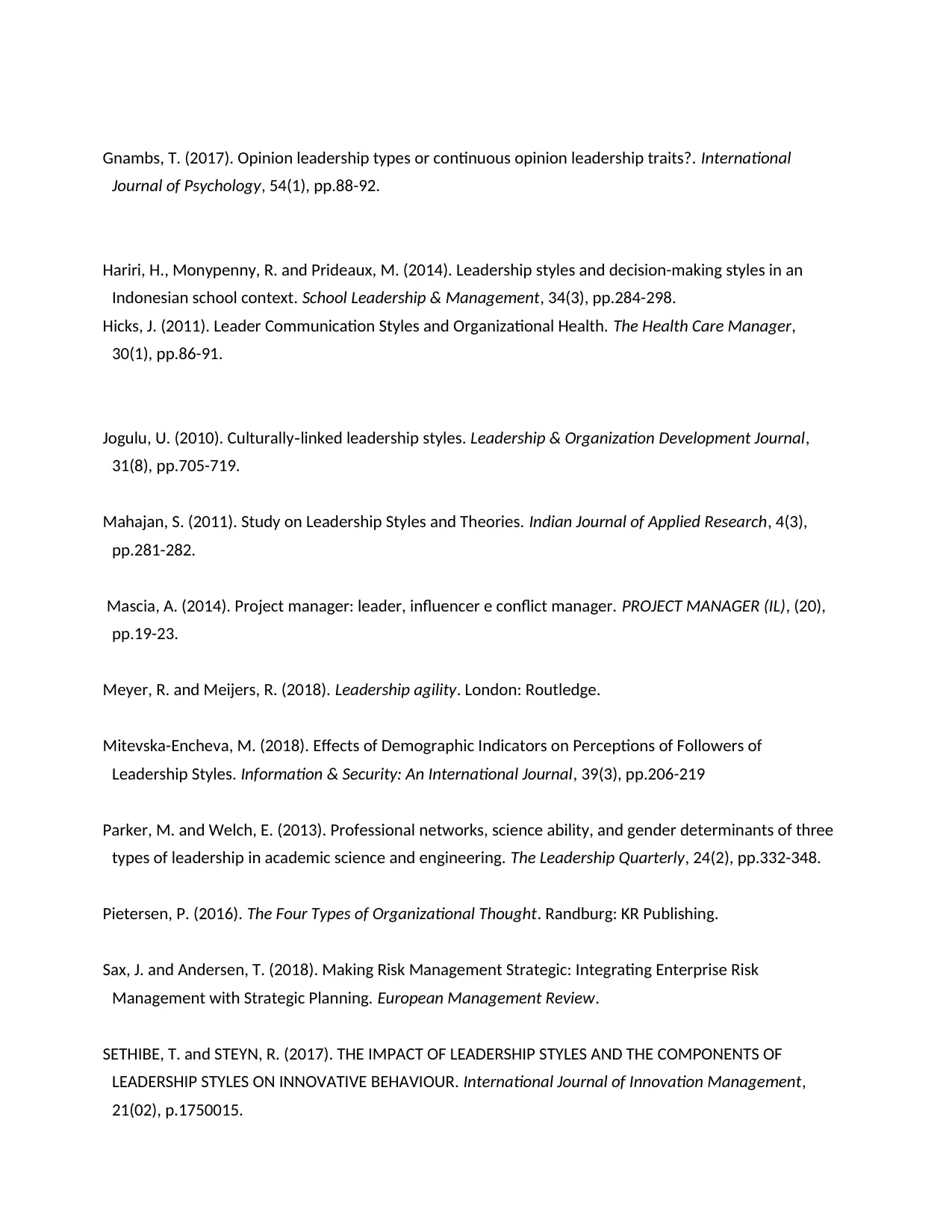
Gnambs, T. (2017). Opinion leadership types or continuous opinion leadership traits?. International
Journal of Psychology, 54(1), pp.88-92.
Hariri, H., Monypenny, R. and Prideaux, M. (2014). Leadership styles and decision-making styles in an
Indonesian school context. School Leadership & Management, 34(3), pp.284-298.
Hicks, J. (2011). Leader Communication Styles and Organizational Health. The Health Care Manager,
30(1), pp.86-91.
Jogulu, U. (2010). Culturally‐linked leadership styles. Leadership & Organization Development Journal,
31(8), pp.705-719.
Mahajan, S. (2011). Study on Leadership Styles and Theories. Indian Journal of Applied Research, 4(3),
pp.281-282.
Mascia, A. (2014). Project manager: leader, influencer e conflict manager. PROJECT MANAGER (IL), (20),
pp.19-23.
Meyer, R. and Meijers, R. (2018). Leadership agility. London: Routledge.
Mitevska-Encheva, M. (2018). Effects of Demographic Indicators on Perceptions of Followers of
Leadership Styles. Information & Security: An International Journal, 39(3), pp.206-219
Parker, M. and Welch, E. (2013). Professional networks, science ability, and gender determinants of three
types of leadership in academic science and engineering. The Leadership Quarterly, 24(2), pp.332-348.
Pietersen, P. (2016). The Four Types of Organizational Thought. Randburg: KR Publishing.
Sax, J. and Andersen, T. (2018). Making Risk Management Strategic: Integrating Enterprise Risk
Management with Strategic Planning. European Management Review.
SETHIBE, T. and STEYN, R. (2017). THE IMPACT OF LEADERSHIP STYLES AND THE COMPONENTS OF
LEADERSHIP STYLES ON INNOVATIVE BEHAVIOUR. International Journal of Innovation Management,
21(02), p.1750015.
Journal of Psychology, 54(1), pp.88-92.
Hariri, H., Monypenny, R. and Prideaux, M. (2014). Leadership styles and decision-making styles in an
Indonesian school context. School Leadership & Management, 34(3), pp.284-298.
Hicks, J. (2011). Leader Communication Styles and Organizational Health. The Health Care Manager,
30(1), pp.86-91.
Jogulu, U. (2010). Culturally‐linked leadership styles. Leadership & Organization Development Journal,
31(8), pp.705-719.
Mahajan, S. (2011). Study on Leadership Styles and Theories. Indian Journal of Applied Research, 4(3),
pp.281-282.
Mascia, A. (2014). Project manager: leader, influencer e conflict manager. PROJECT MANAGER (IL), (20),
pp.19-23.
Meyer, R. and Meijers, R. (2018). Leadership agility. London: Routledge.
Mitevska-Encheva, M. (2018). Effects of Demographic Indicators on Perceptions of Followers of
Leadership Styles. Information & Security: An International Journal, 39(3), pp.206-219
Parker, M. and Welch, E. (2013). Professional networks, science ability, and gender determinants of three
types of leadership in academic science and engineering. The Leadership Quarterly, 24(2), pp.332-348.
Pietersen, P. (2016). The Four Types of Organizational Thought. Randburg: KR Publishing.
Sax, J. and Andersen, T. (2018). Making Risk Management Strategic: Integrating Enterprise Risk
Management with Strategic Planning. European Management Review.
SETHIBE, T. and STEYN, R. (2017). THE IMPACT OF LEADERSHIP STYLES AND THE COMPONENTS OF
LEADERSHIP STYLES ON INNOVATIVE BEHAVIOUR. International Journal of Innovation Management,
21(02), p.1750015.
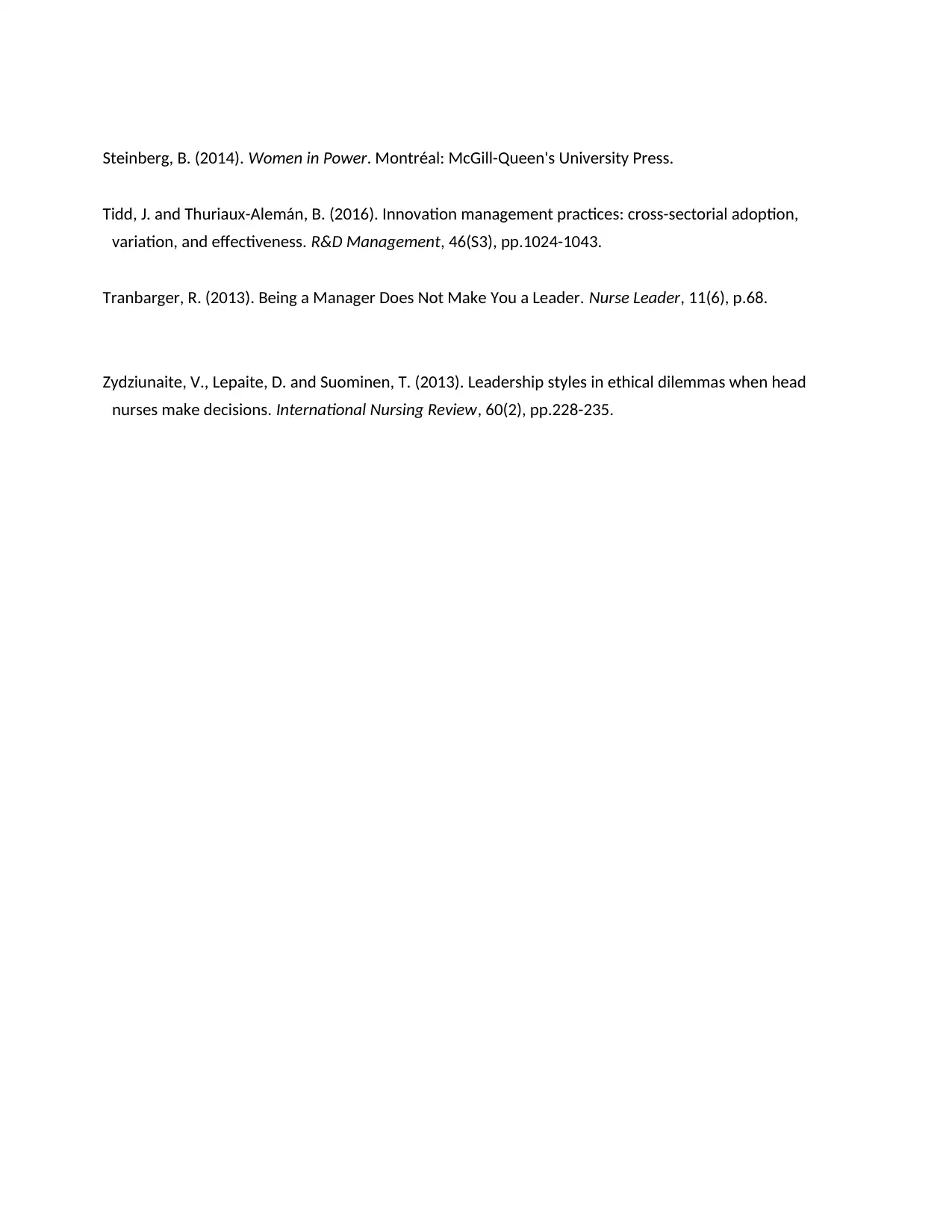
Steinberg, B. (2014). Women in Power. Montréal: McGill-Queen's University Press.
Tidd, J. and Thuriaux-Alemán, B. (2016). Innovation management practices: cross-sectorial adoption,
variation, and effectiveness. R&D Management, 46(S3), pp.1024-1043.
Tranbarger, R. (2013). Being a Manager Does Not Make You a Leader. Nurse Leader, 11(6), p.68.
Zydziunaite, V., Lepaite, D. and Suominen, T. (2013). Leadership styles in ethical dilemmas when head
nurses make decisions. International Nursing Review, 60(2), pp.228-235.
Tidd, J. and Thuriaux-Alemán, B. (2016). Innovation management practices: cross-sectorial adoption,
variation, and effectiveness. R&D Management, 46(S3), pp.1024-1043.
Tranbarger, R. (2013). Being a Manager Does Not Make You a Leader. Nurse Leader, 11(6), p.68.
Zydziunaite, V., Lepaite, D. and Suominen, T. (2013). Leadership styles in ethical dilemmas when head
nurses make decisions. International Nursing Review, 60(2), pp.228-235.
⊘ This is a preview!⊘
Do you want full access?
Subscribe today to unlock all pages.

Trusted by 1+ million students worldwide
1 out of 9
Related Documents
Your All-in-One AI-Powered Toolkit for Academic Success.
+13062052269
info@desklib.com
Available 24*7 on WhatsApp / Email
![[object Object]](/_next/static/media/star-bottom.7253800d.svg)
Unlock your academic potential
Copyright © 2020–2025 A2Z Services. All Rights Reserved. Developed and managed by ZUCOL.





